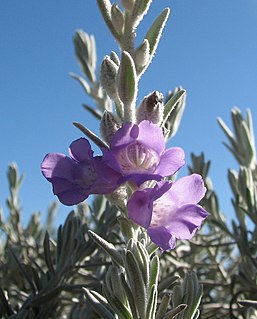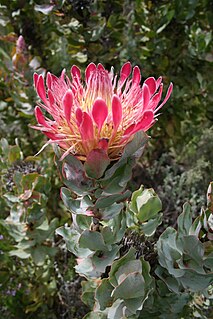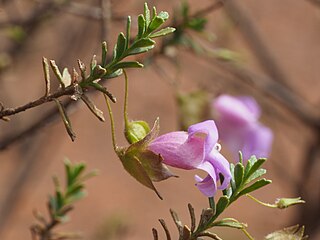
Eremophila nivea, commonly known as silky eremophila, is a flowering plant in the figwort family, Scrophulariaceae and is endemic to Western Australia. In nature it is a rare shrub with hairy branches and leaves, and blue, purple or violet flowers.

Protea eximia, the broad-leaved sugarbush, is a shrub that may become a small tree, which occurs in mountain fynbos on mainly acidic sandy soils; the species was very well known under its old name of Protea latifolia. The flowers have awns that are covered in purple-black velvety hairs, and are contained within a series of rings of involucral bracts that have the appearance of petals. The fruit is a densely hairy nut, many of which are inserted on a woody base. The flowers are borne terminally on long shoots, and have a tendency to become very untidy as they age.

Eremophila bowmanii, also known as silver turkeybush, Bowman's poverty bush and flannel bush, is a flowering plant in the figwort family, Scrophulariaceae and is endemic to New South Wales and Queensland in Australia. It is a low to medium, spreading shrub with silvery-grey, hairy foliage and blue to lilac flowers, and sometimes grows in dense thickets with mulga.

Pelargonium peltatum is a scrambling perennial plant with shallow or deeply five lobed, circular to heart-shaped, somewhat fleshy leaves, sometimes with a differently coloured semicircular band, that has been assigned to the cranesbill family. It carries umbel-like inflorescences with 2–10, white to mauve, bilateral symmetrical flowers, each with a "spur" that is merged with the flower stalk. It is known by several common names including ivy-leaved pelargonium and cascading geranium. It is native to southern and eastern South Africa. In its home range, it flowers year round but most vigoriously from August to October.

Spergularia macrotheca is a species of flowering plant in the family Caryophyllaceae known by the common name sticky sandspurry. It is native to western North America from British Columbia to Baja California, where it grows in many types of moist coastal and inland habitat, often in alkaline and saline substrates. It may be found in marshes, alkali flats, beaches, meadows, seeps, and vernal pools. It is a perennial herb producing a narrow stem up to 40 centimeters long with a woody, thickened base and taproot. They may grow erect or prostrate across the ground. It is covered in sticky glandular hairs, especially in the inflorescence. The stems are lined with fleshy linear leaves, sometimes tipped with spines. The leaves are accompanied by triangular stipules up to a centimeter long each. Flowers occur in clusters at the end of the stem as well as in leaf axils. The small flowers have five pointed sepals and five oval white to lavender-pink petals. The fruit is a capsule containing tiny reddish brown, winged seeds.

Pelargonium cucullatum is a hairy, upright, branching, perennial shrub, of 1–2 m (3.3–6.6 ft) high, that has been assigned to the cranesbill family. It sprouts new stems from the underground rootstock and becomes woody at its base. It has alternately set, sometimes slightly succulent leaves crowded near the top of the branches, with leaf stalks and flat to hood-shaped leaf blades, with a rounded broad triangular to kidney-shaped outline of about 4–5.5 cm long and 5–9 cm wide, often somewhat incised, the margin with irregular teeth. The white to purplish red, 5-merous, somewhat mirror symmetrical flowers grow in umbel-like clusters, and each contain mostly 7 fertile stamens and 3 infertile staminodes of different length. P. cucullatum has been cultivated as a garden ornamental and house plant since the 17th century. It has been used to breed many modern pelargonium hybrids, notably the Regal pelargoniums. It is called hooded-leaf pelargonium or herba althaea in English and wildemalva in Afrikaans.

Viola calcarata is a species of genus Viola that grows on mountains of south-eastern Europe. It is commonly known as long-spurred violet or mountain violet. It is a herbaceous flowering perennial plant.

Eremophila campanulata, commonly known as bell-flowered poverty bush, is a flowering plant in the figwort family, Scrophulariaceae and is endemic to a small area in central Western Australia. It is a small, low, densely branched shrub with small leaves and purple or lilac flowers. Its most distinctive feature is the dark purple sepals at the base of the flowers.

Eremophila ionantha is a flowering plant in the figwort family, Scrophulariaceae and is endemic to Western Australia. It is a shrub with many sticky branches, narrow, light green leaves and blue, purple or violet flowers.
Eremophila pendulina is a flowering plant in the figwort family, Scrophulariaceae and is endemic to Western Australia. It is a tall, spindly, weeping shrub with narrow leaves and purple, mauve or white flowers in autumn and early spring.

Eremophila punctata is a flowering plant in the figwort family, Scrophulariaceae and is endemic to Western Australia. It is an erect shrub with sticky young branches and leaves due to the presence of resin. Its small leaves usually have a few blunt teeth near their ends and flowers which are usually lilac-coloured. It is a distinctive and widespread species.
Eremophila pungens is a flowering plant in the figwort family, Scrophulariaceae and is endemic to Australia. It is an erect, sticky shrub with broad, serrated-edged leaves which end in a sharp spine and purple or violet flowers.

Viola abyssinica is a low perennial plant with long trailing stems and whitish or light purple flowers with purple markings on the lip, that is assigned to the violet family. In the wild it grows in moist grassland, forest glades and margins, at altitudes between 1200 and 3400 m (3900–11.000 ft), in eastern Africa, from South Africa to Ethiopia, in Cameroun and Nigeria, and on Madagascar and Bioko. Vernacular names are bezongozongo in Madagascar, and dukunsha in Ethiopia.

Pelargonium luridum, locally called variable stork's bill, is a medium high, tuberous herbaceous perennial geophyte, belonging to the Stork's bill family, with white to pink, slightly mirror symmetrial flowers in umbels on long unbranched stalks directly from the ground rosette that consists of few initially ovate, later pinnately incised or linear leaves, with blunt teeth around the margin. The variable stork's bill naturally occurs from South Africa to Angola, southern Congo and Tanzania.

Leucospermum saxosum is an upright evergreen shrub of up to 2 m (6.6 ft) high, that is assigned to the family Proteaceae. It has lance-shaped, leathery leaves and egg-shaped flower heads of about 5 cm (2.0 in) in diameter, with initially yellow-orange flowers, later turning crimson, from which long styles stick out, giving the flower head the appearance of a pincushion. It is called escarpment pincushion in English. It grows on quartzite soils in the mountains on the Zimbabwe-Mozambique border and in eastern Transvaal.
Hypericum cuisinii is a perennial herb in the genus Hypericum, in the section Adenosepalum. The herb has pale yellow flowers and occurs in Greece and Turkey.
Olearia adenolasia, commonly known as woolly-glandular daisy-bush, is a species of flowering plant in the family Asteraceae. It is a small upright shrub with sticky leaves and blue-purple or white daisy flowers.

Pelargonium coronopifolium is a subshrub of up to 40 cm high. It has green to slightly greyish, linear to narrowly elliptical leaves often with irregular teeth towards the tip and white to purple flowers in groups of one to four. It can be found in the Western Cape province of South Africa. Old publications suggested the name buck's horn plantain-leaved stork's bill, but this name never gained common use.

Bossiaea decumbens is a spreading, prostrate shrub in the pea family (Fabaceae), and is endemic to Victoria. It has alternate, variable shaped leaves and yellow pea flowers with red splotches from spring to late summer.
Otholobium dreweae is an upright shrublet assigned to the Pea family of about 15 cm (5.9 in) high, that appears after the vegetation burned down from the underground rootstock and forms mat-like clumps of hardly branching, leafy stems. The stems are set with stiff, entire, alternate leaves with a single leaflet and heads consisting of 12-18 initially dark pink, later white, pea-like flowers with a white nectar guide on a peduncle as long as the leaves at the end of the stem. This species is an endemic of the Kleinrivier Mountains in the Western Cape province of South Africa. It mostly flowers in November.
















